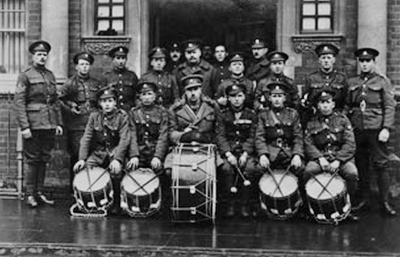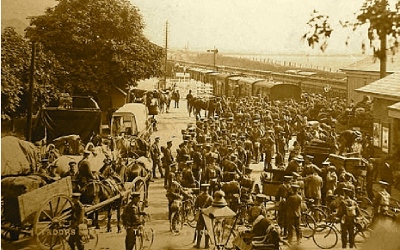How did Thame respond when WW1 broke out?
On 12/08/2014 At 4:44 pm
Category : Missed a ThameNews story?, More News, Thame news
Responses : No Comments
DID you know that part of Lord Williams’s school in Thame was used as a hospital during WW1, that there was a rifle range in Park Street and that Special Constables were drilled every Thursday at the Spread Eagle Thame?

Photograph taken 1918 outside Thame Town Hall – courtesy of Thame Museum http://www.thamemuseum.org/
Leafing through my copy of an excellent history book of Thame written by two Lord Williams’s teachers in the 1930s, I came across some facinating facts about Thame and the Great War, which, as we commemorate 100 years since its outbreak, I thought Thame.Net readers would be interested to learn.
Commonly referred to as ‘Brown and Guest’, the book attempted to cover the entire history of Thame up to 1935, and the following is an extract from Chapter X11 – The War Begins.
“On the Tuesday following the declaration of war came the order of mobilisation, and the next day 41 territorials paraded in the Market Place under Sgt Arnold, and proceeded to Oxford by Train. There they were accommodated in Keble College, and subsequently went into camp at Writtle, two miles from Chelmsford. Those in the Yeomanry, to the number of 80 NCOs and men, were ordered to Henley, and from there to Churn.
“A meeting held early in August decided on the establishment of a VAD (Voluntary Aid Detachment) hospital, and the Old Grammar School (then derelict) was adapted for the purpose, being opened in October, when the necessary alterations in drainage, water supply etc had been completed, by which time £272 had been raised in subscriptions. The reality of war was brlought home by the news of the first casuality, Pte W R Loosley of the Grenadier Guards, who was killed on October 13th; and by the arrival of the first batch of wounded on November 24th, eight British and three Belgiun, all fairly convalescent.
“Recruting proceeded briskly, and by the end of September, 177 local men had joined the colours; but it was still thought that the war would be a short affair, concerning mainly professional soldiers; and that nothing beyond these efforts would be required.
“But the war dragged on. By November 1915, just before attestation under the Derby Scheme began (Ed. The Derby Scheme was a voluntary recruitment policy in Britain created in 1915 by Edward Stanley, 17th Earl of Derby. The intention was that men who voluntarily registered their name would be called upon for service only when necessary. Married men had an added incentive in that they were advised they would be called up only once the supply of single men was exhausted), there were 302 local men serving in the Army and Navy; and the Military Service Act of January 1916 added all able-bodied men as conscripts unless exempted by the local tribunal. In the end there enlisted at Thame 587 officers, NCOs and men (out of a population of 2,957), chiefly in the QOOH (Ed. The Queen’s Own Oxfordshire Hussars), O & BLI (Ed. Oxfordshire and Buckinghamshire Light Infantry) and the 63rd Royal Naval Division; of these, 87 were killed and 200 wounded. At the VAD hospital the number of patients averaged 12 in the early days, but soon increased to 20 or more, the maximum of 36 being reached in January 1918; in all, 612 individual men passed through.
“Those under or over military age, the physically unfit, and the exemptions, found opportunity for service in the Volunteers, who enlisted ‘for the duration’. Of these, S Fairbairn, of Thame Park was the first OC (Ed. Officer Commanding) and Charles Simmons, CSM (Company Sgt Major); drills were held on one night a week and a half-day on Sunday throughout the whole period. The corps was taken over by the War Office in 1917, and issued with uniforms and rifles; some members were drafted to the East Coast for defence work. The rifle range in Park Street (opposite the Fire Staion) was much in use at this time, as also the open range at Bicester.
“In addition, Special Constables, some 30 in number, were sworn in at the beginning of the war, and these have not yet been disbanded. They met for drill weekly on Thursday evenings at the Spread Eagle Assembly Rooms; and their duty was to relieve the regular police by patrolling the streets at night, particularly during air raids, when it was specially importand that people should be warned about their lights.”
From: History of Thame, By J Howard Brown & W Guest: Published in 1935 by F.H. Castle and Co. Ltd of Thame.
Thame Museum currently has an exhibition all about World War One – see website for details.
Also, lots more information about WW1 on the Thame Remembers website


